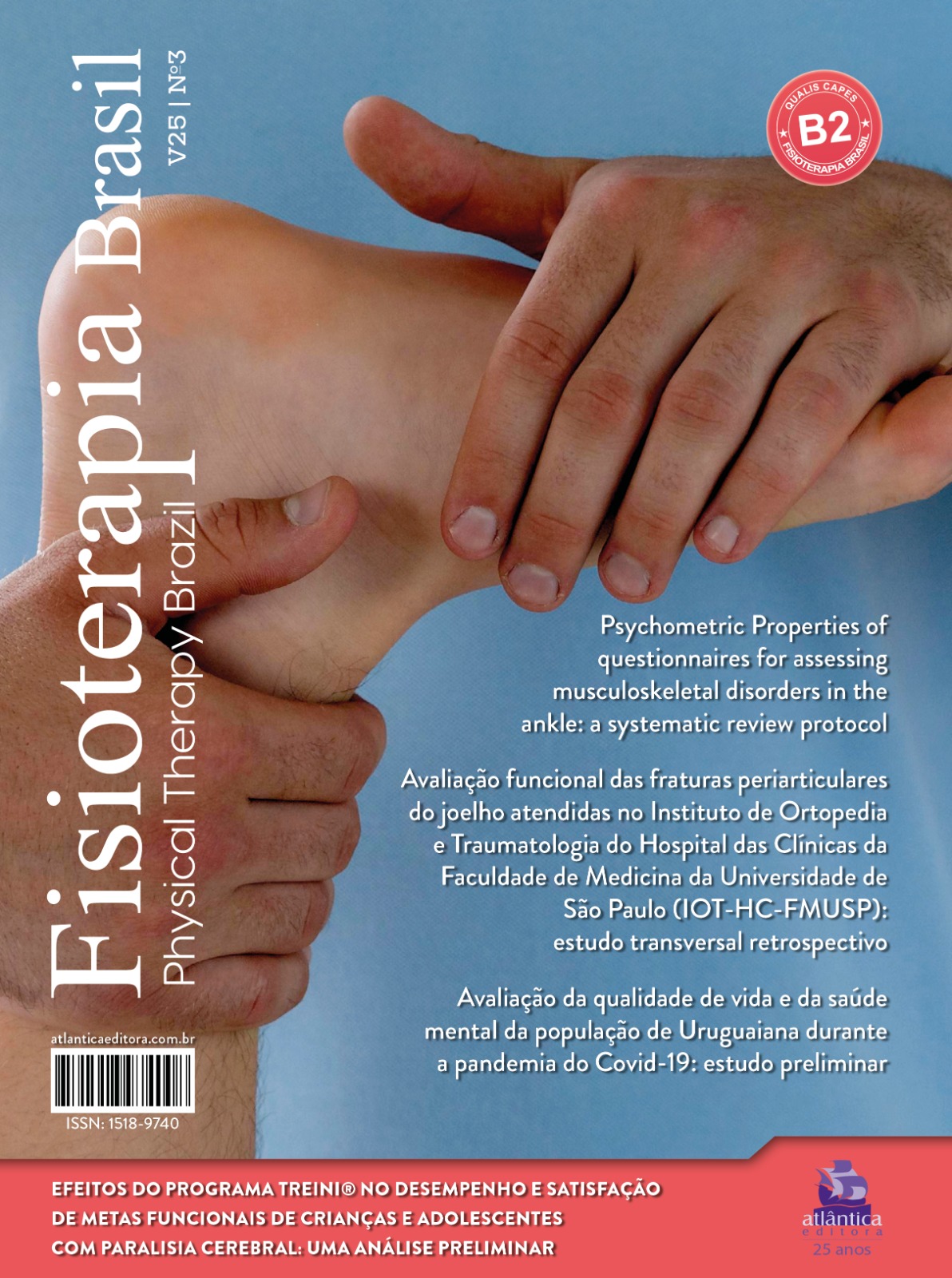Sociodemographic profile of people with diabetics and its correlation with diabetic neuropathy and glycemic control
DOI:
https://doi.org/10.62827/fb.v25i3.1005Keywords:
Diabetes mellitus; diabetic neuropathy; epidemiology.Abstract
Objective: Correlation of the sociodemographic profile with diabetic neuropathy and glycemic control in patients receiving primary health care. Methods: This is a subproject of the project “Risk stratification and sensorimotor intervention for diabetic foot care”, 60 people with diabetes of both sexes aged between 40 and 75 years were included, assisted at UBS João Bosco Pinheiro do municipality of Cuiabá-Mato Grosso. The assessment consists of the application of the Michigan Hand Outcomes Questionnaire, physical examination, collection of sociodemographic data and clinical variables. Results: 34 women and 26 men were included, with an average age of 58.95 years, average weight of 79.09 kg, average height of 1.48, average body mass index of 28.99 kg/m², average systolic blood pressure 132.86mmHg, average blood pressure average diastolic reading of 79.23 mmHg, average time since diagnosis of type 2 Diabetes Mellitus of 9.04 years, average education time of 2.8 years, average Glycated Hemoglobin laboratory test of 8.73% and an average of 4.63 points in the questionnaire Diabetic Distal Polyneuropathy Diagnosis Scale. Conclusion: A slight correlation was found in the variables age, Body Mass Index, Diabetic Polyneuropathy Scale and years of education, concluding the importance of greater years of education for better adherence to treatment due to a better understanding of the drug therapeutic complexity to achieve the glycemic control, being important in management, is the control of body weight and, among complications related to diabetes, we can infer the perception of signs and symptoms of Diabetic Polyneuropathy.
References
Brasil. Ministério da Saúde. Secretaria de Atenção à Saúde. Departamento de Atenção Básica. Manual do pé diabético: estratégia para o cuidado da pessoa com doença crônica/Ministério da Saúde, Secretaria de Atenção de Atenção à Saúde, Departamento de Atenção básica – Brasilia: Ministério da Saúde;2016.
Khan MAB, Hashim MJ, King JK, Govender RD, Mustafa H, Al Kaabi J. Epidemiology of Type 2 Diabetes - Global Burden of Disease and Forecasted Trends. J Epidemiol Glob Health. 2020;10(1):107-111. doi:10.2991/jegh.k.191028.001
Galicia-Garcia U, Benito-Vicente A, Jebari S, et al. Pathophysiology of Type 2 Diabetes Mellitus. Int J Mol Sci. 2020;21(17):6275. Doi:10.3390/ijms21176275
Artasensi A, Pedretti A, Vistoli G, Fumagalli L. Type 2 Diabetes Mellitus: A Review of Multi-Target Drugs. Molecules. 2020;25(8):1987. doi:10.3390/molecules25081987
Kanaley JA, Colberg SR, Corcoran MH, et al. Exercise/Physical Activity in Individuals with Type 2 Diabetes: A Consensus Statement from the American College of Sports Medicine. Med Sci Sports Exerc. 2022;54(2):353-368. doi:10.1249/MSS.0000000000002800
Ministério da Saúde (BR). Plano de reorganização da atenção à hipertensão arterial e ao diabetes mellitus. Brasília, Ministério da Saúde; 2001.
International Diabetes Federation. IDF Diabetes Atlas [Internet]. 6a ed. Brussels: International Diabetes Federation, 2014.
Moreira RO, Castro AP, Papelbaum M, Appolinário JC, Ellinger VCM, et al. Tradução para o português de avaliação e da confiabilidade de uma escala para diagnóstico da polineuropatia distal diabética. Arq Bras Endocrinol Metab. 2005;49:944-950. Disponivel em: https://doi.org/10.1599/50004-2702005000600014
Oliveira PP, Fachin SM,Tozatti J, Ferreira MC, Marinheiro LPF. Análise comparativa do risco de quedas entre pacientes com e sem diabetes mellitus tipo 2. Rev Assoc Med Bras. 2012.58(2): 234-239. Disponivel em: https://doi.org/10.1590/S0104-42302012000200021
Munro BH. Correlation. In: MunroBH. editor. Statistical methods for health care research. 4a. Philadelphia: Lippincott; 2001.p.223---43. Disponível em: http://jumed15.weebly.com/uploads/5/8/7/5/58753271/munro%C3%A2s-statistical-methods-for-healt-care-research.pdf
Santos HC, Ronsoni MF, Colombo BS, Oliveira CS, Hohl A, Coral MH, et al. Escores de neuropatia periférica em diabéticos. 2015; 13(1): 40-45. Disponivel em: http://files.bvs.br/upload/S/1679-1010/2015/v13n1/a4768.pdf
Boell JEW, Ribeiro RM, Da Silva DMGV. Fatores de risco para o desencadeamento do pé diabético. 2014; 16(2): 386-396. Disponível em: https://doi.org/10.5216/ree.v16i2.20460
Grillo MFF, Gorini MIPC. Caracterização de pessoas com Diabetes Mellitus Tipo 2 Rev Bras Enferm 2007; jan-fev; 60(1):49-54. Disponível em: https://doi.org/10.1590/50034-71672007000100009
Ministério da Saúde, Secretaria de Atenção à Saúde, Departamento de Atenção Básica. Brasília: Ministério da Saúde, 2006.
Head KA. Peripheral neuropathy: pathogenic mechanisms and alternative therapies. 2006; 11(4): 294-329. Disponível em: https://pubmed.ncbi.nlm.nih.gov/17176168/
Raccah D, Coste T, Cameron NE, Dufayet D, Vague P, Hohman TC. Effect of the aldose reductase inhibitor tolrestat on nerve conduction velocity, Na/K ATPase activity, and polyols in red blood cells, sciatic nerve, kidney cortex, and kidney medulla of diabetic rats. J Diabetes Complications. 1998;12(3):154-162. doi:10.1016/s1056-8727(97)00093-7
Walker RJ, Smalls BL, Campbell JA, Strom Williams JL, Egede LE. Impact of social determinants of health on outcomes for type 2 diabetes: a systematic review. Endocrine. 2014;47(1):29-48. doi:10.1007/s12020-014-0195-0
Saydah S, Lochner K. Socioeconomic status and risk of diabetes-related mortality in the U.S. Public Health Rep. 2010 May-Jun;125(3):377-88. doi: 10.1177/003335491012500306.
Adler NE, Stewart J. Health disparities across the lifespan: meaning, methods, and mechanisms. Ann N Y Acad Sci. 2010;1186:5-23. doi:10.1111/j.1749-6632.2009.05337.
Gimenes HT, Zanetti ML, Haas VJ. Factores relacionados a la adhesión del paciente diabético a la terapéutica medicamentosa. 2009: 17(1): 46-51. Disponivel em: https://www.scielo.br/j/rlae/a/czZsrR4GfxBbWPg3X6zxpmH/?format=pdf&lang=pt
Rodrigues FF, Santos MA, Teixeira CRS, Gonela JT, Zanetti ML. Relação entre conhecimento, atitude, escolaridade e tempo de doença em indivíduos com diabetes mellitus. 2012; 25(2): 284-290. https://doi.org/10.1590/S0103-21002012000200020
Downloads
Published
Issue
Section
License
Copyright (c) 2024 Maristela Prado e Silva Nazario, Ariane Hidalgo Mansano Pletsch, Yasmin Renata Soares de Lima, Giovana Hidalgo Pletsch, Caroline Senabio Mendes, Osvaldo Borges Pinto Junior (Autor)

This work is licensed under a Creative Commons Attribution 4.0 International License.
Autores que publicam nesta revista concordam com os seguintes termos:
Autores mantém os direitos autorais e concedem à revista o direito de primeira publicação, com o trabalho simultaneamente licenciado sob a Licença Creative Commons Attribution 4.0 que permite o compartilhamento do trabalho com reconhecimento da autoria e publicação inicial nesta revista.
Autores têm autorização para distribuição não-exclusiva da versão do trabalho publicada nesta revista (ex.: publicar em repositório institucional ou como capítulo de livro), com reconhecimento de autoria e publicação inicial nesta revista.


